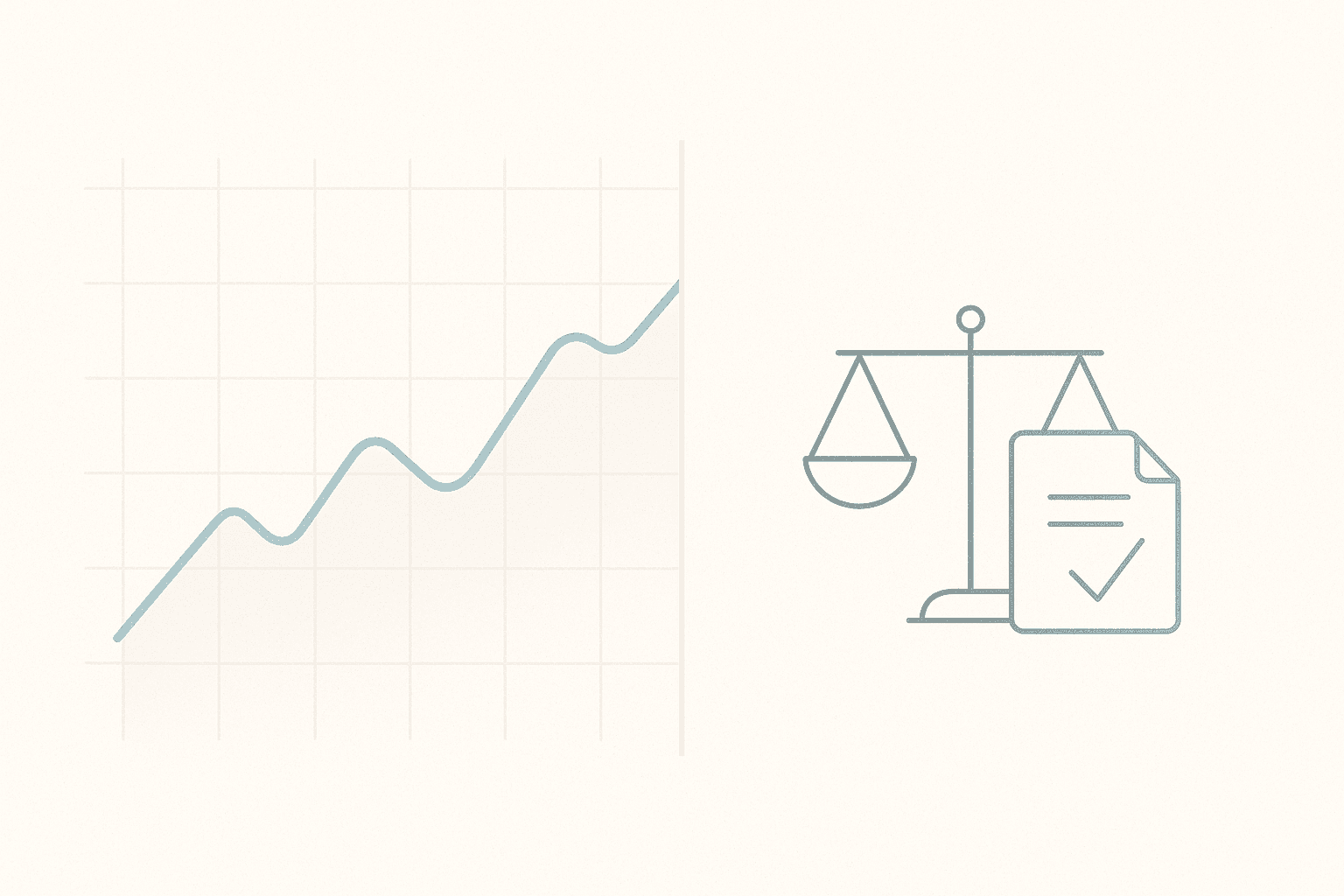AI Lawyer Blog
Content License Agreement Template (Free Download + AI Generator)

Greg Mitchell | Legal consultant at AI Lawyer
3
A Content License Agreement sets the terms under which an owner (licensor) grants another party (licensee) the right to use creative content — text, images, video, music, software code, datasets, or mixed media — under defined conditions. Unlike an assignment, licensing keeps ownership with the licensor while allowing controlled use, revenue sharing, and quality protection.
The creative economy’s scale highlights why clear licenses matter: arts and cultural production contributed $1.17 trillion (4.2% of U.S. GDP) in 2023. Music, one of the most-licensed content verticals, reported $29.6 billion in 2024 global recorded music revenues, the tenth straight year of growth. The U.S. Copyright Office recorded 424,155 copyright registrations in FY 2024, underscoring the volume of works entering commerce.
Download the free Content License Agreement Template or customize one with our AI Generator, then have a local attorney review before you sign.
You Might Also Like:
Contractor Onboarding Checklist Template (Free Download + AI Generator)
Construction Change Order Form Template (Free Download + AI Generator)
1. What Is a Content License Agreement?
A Content License Agreement is a written contract in which a licensor permits a licensee to use specified content for defined purposes, in defined territories, and for a defined time, subject to payment and rules (attribution, quality control, usage restrictions). Licensing enables scale: the same content can power multiple channels or partners without giving up ownership.
Licenses can be exclusive (only one licensee may use the content in the agreed scope) or non-exclusive (many licensees can use it). Variations include sole licenses, field-limited licenses, and subscription or usage-metered models. Agreements can also bundle derivative rights (adaptations, translations) and govern delivery formats, metadata, watermarking, and takedown procedures.
2. Why Content Licensing Matters in 2025?
Content supply and distribution keep fragmenting across platforms, apps, and AI-driven tools. Clear licensing helps creators and companies monetize across formats while controlling brand and quality. AI training and generative outputs have intensified scrutiny on permitted uses, model training rights, and derivative work rules, areas that require explicit license language.
On the buyer side, compliance teams demand auditable rights to avoid platform takedowns, ad-network flags, or store rejections. Global operations also need localization, accessibility, and privacy alignment. A modern license is not only a revenue instrument; it is a compliance shield, spelling out warranties, indemnities, and notice-and-takedown workflows that prevent costly disputes or distribution interruptions.
3. Key Clauses and Components
Parties: Identify licensor and licensee with full legal names and addresses.
Grant of Rights: Define media, channels, formats, permitted uses, exclusivity, territory, and term.
Scope Restrictions: Specify prohibited uses (e.g., endorsements, sensitive contexts, AI training, resale) and any field-of-use limits.
Fees & Payment: State license fee type (flat, royalty, per-impression, per-seat), payment timing, audit rights, and late-payment terms.
Attribution & Credits: Describe credit format and placement; require removal only when impossible or commercially impractical.
Quality Control & Approvals: Set file specs, brand guidelines, review windows, and cure periods for non-conforming uses.
Warranties & Indemnities: Licensor warrants ownership/authority to license; licensee warrants lawful, compliant use; set caps and carve-outs.
IP Protection & Enforcement: Provide for watermarking, DRM, takedown procedures, and cooperation in infringement claims.
Data & Privacy: Address personal data embedded in content; include DPA addendum when needed.
Termination & Remedies: Define breach, cure periods, suspension, takedown, and post-termination wind-down rights.
4. Legal Requirements by Region
United States: Copyright vests in the author; exclusive licenses must be in writing and signed by the rights holder. Fair use and DMCA safe harbors may intersect with licensing, but do not substitute for contractual clarity. Privacy (e.g., state privacy acts) and right-of-publicity laws can limit commercial uses of people’s images and voices.
European Union: Moral rights are robust and often non-waivable; licenses should respect attribution and integrity. GDPR governs personal data in the media; cross-border transfers need proper safeguards. Collective management organizations (CMOs) can affect music, images, or performance rights.
United Kingdom: UK copyright rules align with writing/signature for exclusive licenses; UK GDPR applies to personal data. The CAP Code and ASA guidance influence advertising uses.
Canada & Other Jurisdictions: Written licenses prevail; moral rights can be waived but not assigned in many systems. Sector rules (broadcast, education, public performance) may require additional permissions or tariffs.
5. How to Customize Your Agreement?
Match rights to business model: Streaming, syndication, merchandising, or SaaS embedding each needs a tailored grant.
Tune exclusivity and geography: Limit exclusivity to a field, platform, or region; broaden territory if global distribution is essential.
Pick the royalty logic: Flat fee for simple uses; rev-share or usage-based billing for dynamic channels; add audit windows.
Clarify derivative works: Spell out translation, adaptation, subtitle/dubbing, or AI-assisted edits, and who owns outputs.
Address third-party elements: Fonts, samples, likeness rights, or trademarks may require separate licenses, flag them.
Plan for takedowns: Include notice methods, removal SLAs, replacement content options, and refund/credit mechanisms.
6. Step-by-Step Guide to Drafting and Negotiation
Step 1-Define the content: Name files, versions, metadata, and any third-party elements; attach a content inventory schedule.
Step 2-Choose the rights bundle: Specify media, channels, and exclusivity; set territory and term to match distribution plans.
Step 3-Set pricing and reports: Select fee model, define reporting cadence, provide audit rights, and set payment methods.
Step 4-Add quality and brand controls: Provide specs, review cycles, and cure windows; require brand-safe use and compliance with platform rules.
Step 5-Handle legal safeguards: Draft warranties, caps, and indemnities; include privacy and publicity clauses; add export and sanctions compliance if relevant.
Step 6-Plan for change: Include amendment and change-order mechanics; set force majeure and service-level language for hosting or delivery.
Step 7-Execute and track: Sign in writing; store the agreement, content IDs, and renewals; calendar expirations to avoid accidental overruns.
7. Tips for Risk Reduction and Monetization
License narrowly and upsell expansions: Start with essential rights; sell add-ons for extra channels, geographies, or terms.
Use measurable terms: Tie permitted uses to counts, domains, apps, or seats; avoid ambiguous “global/all media” language unless priced for it.
Control generative/AI uses: State whether training, fine-tuning, or synthetic derivatives are allowed; require provenance logging.
Keep an evidence trail: Watermark, hash, or fingerprint files; keep upload and approval logs to prove authorized use.
Align with marketplaces: If distributing via app stores or ad platforms, mirror their policy language to prevent takedowns.
Balance caps and carve-outs: Indemnity caps help, but keep uncapped carve-outs for IP infringement or willful misconduct.
8. Checklist Before You Finalize
Parties, work titles, file IDs, and versions are listed clearly.
Grant of rights matches business model, territory, term, and media.
Restrictions address endorsements, sensitive uses, and AI/model training.
Fees, royalty mechanics, audit rights, and payment timing are set.
Attribution format, quality controls, and cure periods are defined.
Warranties, indemnities, and liability caps are balanced and lawful.
Privacy, publicity, and data-transfer rules are addressed.
Takedown, suspension, and replacement procedures are included.
Termination, wind-down, and post-term obligations are specified.
Execution, notices, governing law, and dispute forums are confirmed.
Download the Full Checklist Here
9. Common Mistakes to Avoid
Overbroad grants with underpriced fees: too much scope for too little compensation.
Silence on derivatives and AI: missing rules on adaptations, translations, or model training invites disputes.
Ignoring third-party rights: unlicensed fonts, samples, or likenesses can torpedo distribution.
Weak attribution language: unclear credit formats lead to platform flags or conflicts with creators.
No audit or reporting: impossible to verify royalties or usage compliance.
Vague takedown process: delays create partner friction and potential platform penalties.
10. FAQs
Q: What is the difference between exclusive and non-exclusive content licenses?
A: Exclusive licenses grant one licensee the sole right to use the content in the defined scope, often at a premium price, while non-exclusive licenses allow multiple licensees to use the same content. Exclusivity can be limited by field, platform, or territory. The choice depends on your pricing model, distribution strategy, and the licensee’s need for competitive differentiation.
Q: How should I price a content license fairly?
A: Start with intended uses, audience size, and duration, then choose a fee model, flat fee for simple or short-term uses, revenue share or usage-based pricing for scalable distribution. Add price multipliers for exclusivity, additional territories, or derivative rights. Include audit rights and reporting to keep pricing honest and adaptable as usage grows.
Q: Can I license content that includes third-party material?
A: Yes, but you must own or have licensed all embedded elements, such as music samples, fonts, stock images, or likeness rights. Disclose these clearly and ensure the downstream license covers them or requires the licensee to obtain separate permissions. Failing to address third-party rights is a common cause of takedowns and indemnity claims.
Q: How do AI and machine-learning uses affect licensing?
A: Spell out whether training, fine-tuning, or generating derivatives is allowed, and whether outputs belong to the licensee or licensor. Require provenance tracking and prohibit attempts to remove watermarks or metadata. If AI uses are excluded, say so clearly; if allowed, price them appropriately and restrict sensitive categories where necessary.
Q: What happens when a license ends?
A: Most licenses require the licensee to cease new uses, remove content from distribution where feasible, and delete or archive copies except for legal compliance backups. A wind-down period may allow limited continued use to avoid operational disruption. Clear post-term rules and renewal options prevent accidental overuse and disputes.
Sources and References
Market and regulatory data in this article are drawn from official and publicly available materials, including the U.S. Bureau of Economic Analysis (BEA) Arts and Cultural Production Satellite Account 2023, the IFPI Global Music Report 2024, and the U.S. Copyright Office Annual Report FY 2024.
Legal and compliance references are based on the U.S. Copyright Act, DMCA guidelines, and Investor.gov resources on copyright and intellectual property.
Regional notes reference the EU GDPR framework, the UK CAP Code and ASA Advertising Guidance, and the Canadian Intellectual Property Office (CIPO) copyright guidance.
Supplementary data reflect OECD and WIPO reporting on global creative industries, collective management, and digital licensing trends.
Disclaimer
This article is for informational purposes only and does not constitute legal advice. Copyright, moral rights, privacy, and platform rules vary by jurisdiction and can change. Always consult a qualified attorney before drafting, signing, or relying on a Content License Agreement.
Get Started Today!
A precise Content License Agreement helps you monetize safely, expand reach, and protect brand integrity across platforms and formats. Draft it to fit your business model, then track usage diligently.
Download the free Content License Agreement Template or customize one with our AI Generator, then have a local attorney review before you sign.
You Might Also Like:



